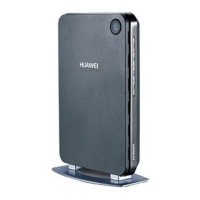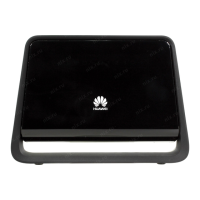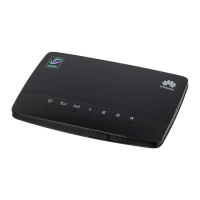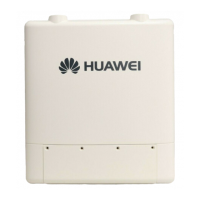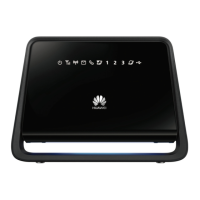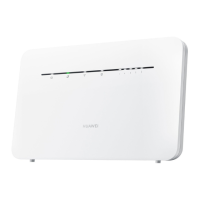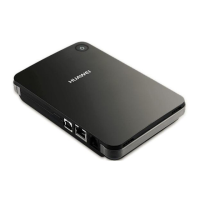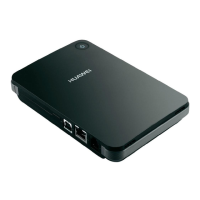Do you have a question about the Huawei B970b and is the answer not in the manual?
Details regarding HUAWEI trademarks and other company product names.
Information about the warranty limitations and disclaimers for the manual's content.
Guidelines for complying with export and import laws for the product.
Description of the device's physical features and indicator lights.
Recommended computer configurations for using the gateway.
Step-by-step instructions for inserting the SIM card.
Instructions for connecting the power adapter and a PC via Ethernet.
Connecting a telephone set and positioning the device for optimal signal.
Optional step for connecting an external antenna for improved signal reception.
Explanation of how the device connects to the internet via dial-up.
Steps to access and log into the device's management interface.
Procedure for establishing an internet connection, including PIN code entry.
Instructions on how to reset the device to its original factory settings.
Overview of the management page layout and its operation functions.
How to view current parameter and network connection status.
Setting up profile name, dial-up number, user name, password, and APN.
Selecting dial-up access mode (Auto, On Demand, Manual) and authentication.
Setting up the wireless network name (SSID) for the WLAN.
Enabling or disabling the broadcast of the WLAN SSID for security.
Configuring WPA-PSK, WPA2-PSK, and WEP encryption for WLAN security.
Prerequisites for PC wireless network setup, including WLAN adapter support.
Step-by-step guide to connecting your PC to the wireless network.
Steps to configure IP address and DNS settings for the PC.
Instructions to disable proxy server settings in Internet Options.
Managing system settings and changing the login password for security.
Procedure for upgrading the device's firmware to the latest version.
How to restart the device and view its current firmware version.
Enabling or disabling the SIM card's PIN code protection.
Changing the PIN code and enabling/disabling auto PIN validation.
Selecting the preferred network mode (e.g., 2G, 3G) and band for connection.
Configuring the device to automatically or manually search for networks.
Configuring PPP profile, connection mode, authentication, and idle time.
Creating, changing, and deleting PPP profiles for dial-up connections.
Configuring DHCP server, IP address range, and lease time for the LAN.
Configuring clip settings, including clip mode.
Instructions to enable or disable the wireless local area network (WLAN).
Configuring SSID, AP isolation, country, and channel for basic WLAN operation.
Selecting the optimal 802.11 mode and configuring transmission rate.
Configuring MAC address filtering to control network access.
Setting up authentication methods and encryption modes for WLAN security.
Managing MAC addresses for access control over WLAN clients.
Configuring WLAN bridge settings like preamble type, association limit, and modes.
Enabling and configuring the device's firewall for network protection.
Setting up MAC and IP address filters to restrict network access.
Configuring virtual servers to allow external access to LAN services.
Configuring a DMZ host for unlimited Internet access, with security considerations.
Enabling or disabling the Universal Plug and Play (UPnP) service.
Enabling and configuring remote web management for device control.
Steps to resolve problems when a PC cannot access the Internet via LAN.
Troubleshooting steps for PCs unable to connect to the WLAN.
Resolving issues when bridging between devices is unsuccessful.
Addressing low download rates when signal strength is normal.
Precautions for using the device around other electronic equipment.
Guidelines for use around medical devices and pacemakers.
Safety measures for using the device in areas with explosive potential.
Safety advice for using the device while driving and in vehicles.
Recommendations for optimal operating conditions and environmental factors.
Ensuring children's safety when using the device and its accessories.
Information on using approved accessories and safe charger operation.
Guidelines for cleaning and maintaining the device and its accessories.
Information on proper disposal and recycling of the device and batteries.
Details on compliance with REACH and RoHS directives.
Details regarding HUAWEI trademarks and other company product names.
Information about the warranty limitations and disclaimers for the manual's content.
Guidelines for complying with export and import laws for the product.
Description of the device's physical features and indicator lights.
Recommended computer configurations for using the gateway.
Step-by-step instructions for inserting the SIM card.
Instructions for connecting the power adapter and a PC via Ethernet.
Connecting a telephone set and positioning the device for optimal signal.
Optional step for connecting an external antenna for improved signal reception.
Explanation of how the device connects to the internet via dial-up.
Steps to access and log into the device's management interface.
Procedure for establishing an internet connection, including PIN code entry.
Instructions on how to reset the device to its original factory settings.
Overview of the management page layout and its operation functions.
How to view current parameter and network connection status.
Setting up profile name, dial-up number, user name, password, and APN.
Selecting dial-up access mode (Auto, On Demand, Manual) and authentication.
Setting up the wireless network name (SSID) for the WLAN.
Enabling or disabling the broadcast of the WLAN SSID for security.
Configuring WPA-PSK, WPA2-PSK, and WEP encryption for WLAN security.
Prerequisites for PC wireless network setup, including WLAN adapter support.
Step-by-step guide to connecting your PC to the wireless network.
Steps to configure IP address and DNS settings for the PC.
Instructions to disable proxy server settings in Internet Options.
Managing system settings and changing the login password for security.
Procedure for upgrading the device's firmware to the latest version.
How to restart the device and view its current firmware version.
Enabling or disabling the SIM card's PIN code protection.
Changing the PIN code and enabling/disabling auto PIN validation.
Selecting the preferred network mode (e.g., 2G, 3G) and band for connection.
Configuring the device to automatically or manually search for networks.
Configuring PPP profile, connection mode, authentication, and idle time.
Creating, changing, and deleting PPP profiles for dial-up connections.
Configuring DHCP server, IP address range, and lease time for the LAN.
Configuring clip settings, including clip mode.
Instructions to enable or disable the wireless local area network (WLAN).
Configuring SSID, AP isolation, country, and channel for basic WLAN operation.
Selecting the optimal 802.11 mode and configuring transmission rate.
Configuring MAC address filtering to control network access.
Setting up authentication methods and encryption modes for WLAN security.
Managing MAC addresses for access control over WLAN clients.
Configuring WLAN bridge settings like preamble type, association limit, and modes.
Enabling and configuring the device's firewall for network protection.
Setting up MAC and IP address filters to restrict network access.
Configuring virtual servers to allow external access to LAN services.
Configuring a DMZ host for unlimited Internet access, with security considerations.
Enabling or disabling the Universal Plug and Play (UPnP) service.
Enabling and configuring remote web management for device control.
Steps to resolve problems when a PC cannot access the Internet via LAN.
Troubleshooting steps for PCs unable to connect to the WLAN.
Resolving issues when bridging between devices is unsuccessful.
Addressing low download rates when signal strength is normal.
Precautions for using the device around other electronic equipment.
Guidelines for use around medical devices and pacemakers.
Safety measures for using the device in areas with explosive potential.
Safety advice for using the device while driving and in vehicles.
Recommendations for optimal operating conditions and environmental factors.
Ensuring children's safety when using the device and its accessories.
Information on using approved accessories and safe charger operation.
Guidelines for cleaning and maintaining the device and its accessories.
Information on proper disposal and recycling of the device and batteries.
Details on compliance with REACH and RoHS directives.

